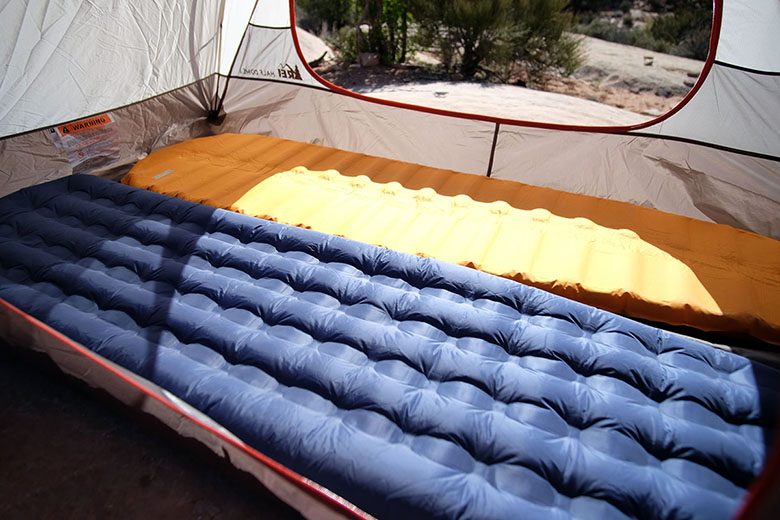
Have you ever wondered whether inflatable sleeping pads are better than foam pads? If so, you’re in the right place! In this article, we’ll dive into the pros and cons of both types of sleeping pads, so you can make an informed decision for your outdoor adventures. Whether you’re a seasoned camper or just starting out, understanding the differences between inflatable and foam pads can greatly enhance your sleeping comfort while camping. So, let’s get started and find out which type of pad suits your needs best!
When it comes to sleeping pads, there are two main options: inflatable pads and foam pads. Inflatable pads, as the name suggests, are filled with air and can be easily inflated and deflated. They are typically lighter and more compact when packed, making them a preferred choice for backpackers and hikers. On the other hand, foam pads are made of closed-cell foam that provides insulation and cushioning. Although bulkier and heavier, foam pads offer great durability and don’t require inflation, making them more reliable in rough terrains.
Now that you know the basics, let’s dig deeper into the advantages and disadvantages of each type. Inflatable sleeping pads are praised for their superior comfort and support, as the air-filled chambers conform to your body shape and provide a more cushioned feel. They also offer adjustable firmness, allowing you to customize your sleeping surface according to your preferences. However, they are more prone to punctures and require maintenance, such as regular inflation and occasional repairs.
Foam pads, on the other hand, are known for their simplicity and reliability. They provide consistent insulation and cushioning throughout the night, without the risk of deflation. Foam pads are also more resistant to punctures and spills, making them a great choice for rugged terrains or for those who need extra durability. However, they may not offer the same level of cushioning and firmness as their inflatable counterparts.
In conclusion, whether inflatable sleeping pads are better than foam pads depends on your personal preferences and camping needs. While inflatable pads offer superior comfort and adjustable firmness, they require maintenance and are more prone to punctures. Foam pads, on the other hand, provide reliability, insulation, and durability, but may not offer the same level of cushioning. We hope this article has helped shed some light on the topic, and remember, both types have their pros and cons, so choose the one that fits your camping style and ensures a good night’s sleep in the great outdoors!

This image is property of sectionhiker.com.
Comparing Inflatable Sleeping Pads to Foam Pads
Are inflatable sleeping pads better than foam pads? This is a common question among camping enthusiasts who are looking for the perfect sleeping pad to enhance their outdoor sleeping experience. While both options have their advantages, it ultimately depends on your individual needs and preferences. In this article, we will compare the benefits of inflatable sleeping pads to foam pads, and explore the factors you should consider when choosing the right sleeping pad for your camping adventures.
Benefits of Inflatable Sleeping Pads
Lightweight and Compact
One of the biggest advantages of inflatable sleeping pads is their lightweight and compact design. These pads are made from lightweight materials such as nylon or polyester, making them easy to carry and transport. When deflated, they can be rolled up or folded into a small, compact size, allowing for easy storage in your backpack or camping gear. This makes them an excellent choice for backpackers or those who prefer to minimize their load while on the go.
Adjustable and Customizable
Inflatable sleeping pads offer a high level of adjustability and customization. Most inflatable pads come with built-in air chambers or valves that allow you to adjust the level of firmness or softness to suit your preferred sleeping position and comfort level. You can easily inflate or deflate the pad to find the perfect balance of support and cushioning for a good night’s sleep in the outdoors.
Provides Insulation and Comfort
Another significant benefit of inflatable sleeping pads is their ability to provide insulation and comfort. These pads are designed to create a layer of air between you and the ground, which helps to insulate your body and prevent heat loss. Some inflatable pads even feature insulated materials that further enhance their heat retention properties, making them suitable for cold weather camping. Additionally, the air-filled chambers of these pads offer a comfortable and cushioned surface to sleep on, relieving pressure points and promoting a restful sleep.

This image is property of images.squarespace-cdn.com.
Advantages of Foam Pads
Affordable and Long-lasting
Foam sleeping pads are a popular choice among campers due to their affordability and longevity. Unlike inflatable pads, foam pads are made from dense foam materials that do not require inflation or deflation. This eliminates the risk of punctures or leaks that can impact the performance of inflatable pads. Foam pads are also known for their durability and can last for many years with proper care and maintenance, making them a cost-effective investment for frequent campers.
Good Insulation and Stability
Foam pads offer excellent insulation and stability. The thick foam layers act as a barrier between your body and the cold ground, helping to keep you warm and comfortable throughout the night. These pads are also known for their stability and resistance to shifting during sleep, ensuring a solid and supportive surface for a night of undisturbed rest. Additionally, foam pads are denser than inflatable pads, making them less likely to compress under your weight and lose their insulating properties over time.
Self-inflatable Options
While foam pads do not offer the same level of adjustability as inflatable pads, there are self-inflating foam pad options available in the market. These pads feature a combination of foam and air chambers, allowing for some customizability in terms of firmness and comfort. Self-inflating foam pads are convenient as they can be quickly inflated with a few breaths and easily rolled up for storage. However, it’s important to note that the self-inflation process may not result in the same level of customization as manually inflating an inflatable pad.
Factors to Consider When Choosing a Sleeping Pad
When choosing between inflatable sleeping pads and foam pads, there are several factors you should consider to ensure you select the right sleeping pad for your needs.
Weight and Portability
If you prioritize weight and portability, inflatable sleeping pads are the clear winner. These pads are lightweight and can be easily rolled or folded into a compact size, allowing for easy transportation during your camping trips. Foam pads, while durable and long-lasting, tend to be bulkier and heavier, which may be a concern for backpackers or hikers who need to carry their gear for long distances.
Insulation and R-Value
Insulation is a crucial factor to consider, especially if you plan to camp in colder temperatures. Inflatable sleeping pads with higher R-values provide better insulation against the cold ground. R-value measures a pad’s ability to resist heat loss, with higher values indicating better insulation. Foam pads generally have higher R-values compared to inflatable pads, making them a suitable choice for cold weather camping.
Comfort and Support
Both inflatable sleeping pads and foam pads offer different levels of comfort and support. Inflatable pads can be adjusted to your desired firmness, allowing you to personalize your sleeping experience. Foam pads, on the other hand, provide a more stable and supportive surface due to their dense foam construction. Ultimately, the level of comfort and support you prefer will guide your decision between the two options.
Durability and Longevity
When investing in a sleeping pad, it’s important to consider its durability and longevity. Inflatable sleeping pads are susceptible to potential punctures or leaks, which can impact their performance and lifespan. However, high-quality inflatable pads made from durable materials can offer excellent resilience and longevity. Foam pads, on the other hand, are known for their durability and ability to withstand years of regular use. Proper care and maintenance can significantly extend the lifespan of both types of sleeping pads.

This image is property of hikingandfishing.com.
Inflation and Deflation Process
Understanding the inflation and deflation process of sleeping pads is essential for their proper use and storage.
Inflating an Inflatable Sleeping Pad
To inflate an inflatable sleeping pad, locate the air valve and open it. Some pads may require you to blow into the valve manually, while others may have a built-in pump or a separate inflation bag. Inflate the pad until it reaches your desired firmness. Once inflated, close the valve to prevent air from escaping during the night.
Deflating an Inflatable Sleeping Pad
To deflate an inflatable sleeping pad, open the air valve and gently press down on the pad to release the air. Starting from one end, roll or fold the pad tightly to remove any remaining air. Once completely deflated, secure the pad with the provided straps or store it in a stuff sack for easy transportation.
Rolling and Packing Foam Pads
Foam pads do not require the inflation or deflation process. To pack a foam pad, simply roll it tightly from one end to the other, similar to rolling up a yoga mat. Secure the rolled pad with straps or use a dedicated stuff sack for storage.
Comparison of Size and Weight
Size and Thickness of Inflatable Sleeping Pads
Inflatable sleeping pads are available in various sizes and thicknesses to accommodate different sleeping preferences. Standard sizes range from small (20 inches wide) to extra-large (30 inches wide), with lengths typically around 72 inches. The thickness varies depending on the model and brand, with common options ranging from 1 to 3 inches. Thicker pads tend to provide more cushioning and insulation, but they can also be bulkier and heavier.
Bulkiness and Weight of Foam Pads
Foam pads are generally bulkier and heavier compared to inflatable pads, due to their solid foam construction. The thickness of foam pads can vary from 0.5 inches to 2 inches or more, with wider and thicker pads offering increased comfort and insulation. It’s important to consider the bulkiness and weight of foam pads if you are concerned about portability and ease of transportation.

This image is property of www.outdoorlife.com.
Insulation and Comfort Levels
Insulation Properties of Inflatable Sleeping Pads
Inflatable sleeping pads provide insulation by creating a barrier of air between your body and the cold ground. The insulation properties of inflatable pads are influenced by the pad’s design, materials, and R-value. Higher R-values indicate better insulation, making inflatable pads with higher R-values suitable for camping in colder temperatures.
Comfort and Cushioning provided by Foam Pads
Foam pads offer excellent comfort and cushioning due to their dense foam construction. The foam molds to the shape of your body, providing reliable support and pressure point relief. Foam pads are known for their stability and ability to prevent the “bottoming out” sensation that can occur with thinner inflatable pads. However, it’s important to choose the right thickness and density of foam to ensure optimum comfort and support.
Versatility and Customization
Adjustability and Firmness Control of Inflatable Sleeping Pads
Inflatable sleeping pads offer a high level of customizability and adjustability. Most pads come with built-in air chambers or valves that allow you to inflate or deflate the pad to your desired firmness. By adjusting the level of air, you can personalize the pad’s comfort and support based on your sleeping position and personal preference.
Modular Options and Customization of Foam Pads
While foam pads do not offer the same level of adjustability as inflatable pads, they do provide some level of customization. Foam pads are available in different densities and thicknesses, allowing you to choose the level of comfort and support that suits your needs. Some foam pads even come with removable layers or modular designs that allow you to adjust the pad’s thickness or add extra cushioning as desired.

This image is property of www.switchbacktravel.com.
Durability and Lifespan
Longevity and Resistance to Wear of Inflatable Sleeping Pads
The durability of inflatable sleeping pads can vary depending on the quality of materials used. High-quality pads made from durable nylon or polyester fabrics are more resistant to punctures and wear, ensuring a longer lifespan. However, it’s important to handle inflatable pads with care and avoid sharp or abrasive surfaces to minimize the risk of damage.
Durability and Resilience of Foam Pads
Foam pads are known for their durability and resistance to wear. Unlike inflatable pads, foam pads do not have the risk of punctures or leaks that can impact their performance. With proper care and maintenance, foam pads can last for many years of regular use, making them a reliable choice for long-term camping adventures.
Price Range and Affordability
Cost of Inflatable Sleeping Pads
The cost of inflatable sleeping pads can vary depending on the brand, size, and features. Basic models with lower R-values and fewer customization options are generally more affordable, ranging from $20 to $50. Higher-end inflatable pads with advanced insulation properties, increased ease of inflation, and greater adjustability can range from $50 to $200 or more.
Price Variations and Accessibility of Foam Pads
Foam pads tend to be more affordable compared to high-end inflatable pads. Basic foam pads with standard thickness and density are available at lower price points, ranging from $10 to $50. Thicker foam pads with additional features such as self-inflation or modular options can cost between $50 and $150. Foam pads are widely accessible and can be found at outdoor retailers, camping stores, and online platforms.
Conclusion
When comparing inflatable sleeping pads to foam pads, it’s important to consider your individual camping needs and preferences. Both options have their advantages and disadvantages, and the right choice ultimately depends on factors such as weight and portability, insulation and comfort levels, versatility and customization, durability and lifespan, and overall affordability. By weighing the pros and cons and considering these factors, you can make an informed decision to select the perfect sleeping pad that will enhance your camping experience and ensure a restful night’s sleep in the great outdoors. Happy camping!





